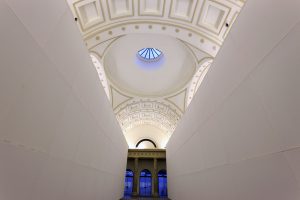
2.892
“2,892 is the cipher-titIe of Daniel Senise’s project. It refers to the blurring of extreme experiences and numerical data, as touched upon by the exhibition’s central piece; a monumental scale installation of facing giant screens made of used bed linens from a motel and from the INCA — the National Cancer Institute of Rio de Janeiro.
Without specific commentary on the dramas of the unknown, Senise obtained, with the help of a mathematician, a practical calculation for the number of people in each establishment who had passed between these sheets during their useful six-month lifespan. Thus, he arrived at the title for each side of the installation – White 462 refers to the movement in the hospital and White 2430 in the motel. Added together they equal “2,892.”
But we know Daniel Senise is not an artist fascinated by numbers exactly. His research basically explores the universe of painting, even though it’s been many years since he’s worked as a painter in the strict sense. […]
ln 2,892, as in other exhibitions, the artist chooses mundane objects as his artistic media, and he preserves (or forges) the marks of time impressed on perishable materials. As such, he captures the everyday memories of these worn-out materials and transfigures them into works of art. Intervening minimally with the surfaces that he appropriates, Senise allows the signs of wear to mark the work, as in the case of the bed linen. With no further illustration of any kind, the patches and stains on the sheets evoke mental images and anonymous stories that provide a singular narrativity to the installation.
In distancing himself from the customary pictorial process, today Daniel Senise works in formats that escape Iiterality. By presenting formal opposition, he comments on issues relative to painting and representation of the world without relying on figuration. Thus, he conveys reflections about the nature/culture binomial in the worn bed sheets, as well as in the grayed mass of recycled papers.”
(excerpt from text by Daniela Labra published in the catalogue of the artist’s exhibition at Casa França-Brasil, Rio de Janeiro, 2011)
Between 1993 and 2011 Daniel Senise created an installation that consisted of two long white panels facing each other, entitled Branco 2430 and Branco 462 (White 2430 and White 462). The addition of their numbers gave the work its title, 2892. The panels were composed of segments forming different grid patterns on each side. Upon closer inspection, those patterns revealed themselves to be composed of double and single white bedsheets.1 Senise’s project began by donating new bedsheets to a motel and to a cancer hospital. At the end of their use, the sheets were returned to the artist, stretched and later placed within a gallery space. On one side are those used by the motel (White 2430), on the other, those from the hospital (White 462).
The enigmatic title of the work refers to the estimated number of bodies that have passed through both groups of sheets. The distinct pattern of each grid is determined by the previous use of the sheets, the association of the double bed with sex, and of the single bed with terminal illness.
The installation invoked temporality, framing the time between the moment of conception and of death. The apparently blank ‘walls’ stand as parentheses between which the viewer passes. Walking through the work, one becomes conscious of one’s own being, one’s own life. The work appeals in this way to ontological enquiry. It speaks at once of a multitude of bodies inviting reflection on one’s own singular being.
(excerpt from by Michael Asbury published in the book Today Is Always Yesterday, by Reaktion Books Ltd, uk, 2023)
“A crucial item must be added to this series: the shroud. The fabric that wipes off sweat, that takes imprints, that retains material and retains stains, blood and cells within its weave. Senise has been investigating the use of the shroud since the early days of his artistic career and applied this technique in many ways. He has collected hundreds of sheets from hospitals and motels. This material holds all sorts of stains, from bloodstains to semen, and together they relate pleasure and pain, life and death. The work 2.892 features these sheets stretched along two large structures at Casa França-Brasil, those from hospitals on one side and from motels on the other, opposite each other to form two large white walls along which visitors move as if it were Hobbema’s avenue. This may be the artist’s point of view: perspective is a reality within which we place ourselves with our perplexity in face of life and death. On the other hand, the white elements formed into two large walls are on some level a quality of light. Let us return to the beginning of this piece where we spoke of the pictorial aspect of Senise’s work and its effects of light and shade. ln fact, this beginning in which shade is clearly overpowering gradually gives way to light, so that even reddish and yellow earthen tones progressively yield to whites. White rectangles are given prominence as openings of light, a type of opaque light that illuminates that which it circumscribes with a sober mystical luminescence. Where is this refined light found in the history of painting? From which painter has it originated? Certainly, not from Malevich’s supremacist white. The nature of this light is not from an external source. It is rather a welcoming white that expresses on its level the light of painting, a light that occurs only in and through painting and becomes a given of the real; an object coming from a wave whose emission is mental, material and intellectual. It is a mode of perception and thought.”
(excerpt from text “Almost Infinite”, by Alberto Saraiva, published in 2018 in “Quase Aqui: Daniel Senise”, APC, São Paulo)